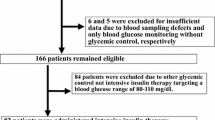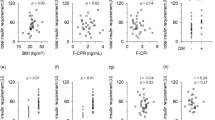Abstract
Strict glycemic control needs to be maintained in critically ill surgical patients to reduce the mortality and morbidity due to hyperglycemia and associated infection. However, conventional intensive insulin therapy (IIT), which consists of intermittent blood glucose measurement and manually controlled infusions of insulin, tends to induce hypoglycemia and glucose variability. Many randomized clinical trials have been conducted to improve the efficacy of IIT, although some of these were stopped owing to frequent hypoglycemia. In pursuing safe and strict glycemic control for critically ill surgical patients, we found that a closed-loop glycemic control system was able to maintain appropriate blood glucose levels without hypoglycemia in more than 400 clinical cases. Considering the need for the perioperative and intensive care environment, a well-established artificial pancreas was modified into a new closed-loop glycemic control system, called the progressive artificial pancreas. The new device is slim in shape and shows clinical compatibility with the conventional artificial pancreas. We herein review this new closed-loop glycemic control system and the expectations for its future application in critically ill surgical patients.
Similar content being viewed by others
References
Ramos M, Khalpey Z, Lipsitz S, Steinberg J, Panizales MT, Zinner M, et al. Relationship of perioperative hyperglycemia and postoperative infections in patients who undergo general and vascular surgery. Ann Surg 2008;248:585–591.
Ambiru S, Kato A, Kimura F, Shimizu H, Yoshidome H, Otsuka M, et al. Poor postoperative blood glucose control increases surgical site infections after surgery for hepato-biliary-pancreatic cancer: a prospective study in a high-volume institute in Japan. J Hosp Infect 2008;68:230–233.
Hanazaki K, Maeda H, Okabayashi T. Relationship between perioperative glycemic control and postoperative infections. World J Gastroenterol 2009;15:4122–4125.
Scott JF, Robinson GM, French JM, O’Connell JE, Alberti KG, Gray CS. Glucose potassium insulin infusions in the treatment of acute stroke patients with mild to moderate hyperglycemia: the glucose insulin in stroke trial (GIST). Stroke 1999;30:793–799.
Hanazaki K, Maeda H, Okabayashi T. Tight perioperative glycemic control using an artificial endocrine pancreas. Surg Today 2010;40:1–7.
Furnary AP, Zerr KJ, Grunkemeier GL, Starr A. Continuous intravenous insulin infusion reduces the incidence of deep sternal wound infection in diabetic patients after cardiac surgical procedures. Ann Thorac Surg 1999;67:352–360; discussion 360–2.
Van den Berghe G, Wouters P, Weekers F, Verwaest C, Bruyninckx F, Schetz M, et al. Intensive insulin therapy in critically ill patients. N Engl J Med 2001;345:1359–1367.
Van den Berghe G, Wilmer A, Hermans G, Meersseman W, Wouters PJ, Milants I, et al. Intensive insulin therapy in medical ICU. N Engl J Med 2006;354:449–461.
Brunkhorst FM, Engel C, Bloos F, Meier-Hellmann A, Ragaller M, Weiler N, et al. Intensive insulin therapy and pentastarch resuscitation in severe sepsis. N Engl J Med 2008;358:125–139.
Devos P, Preiser JC, Mélot C; on behalf of the Glucontrol Steering Committee. Impact of tight glucose control by intensive insulin therapy on ICU mortality and the rate of hypoglycaemia: final results of the Glucontrol study (abstract). Intensive Care Med 2007;33:S189.
NICE-SUGAR Study Investigators; Finfer S, Chittock DR, Su SY, Blair D, Foster D, Dhinga V, et al. Intensive versus conventional glucose control in critically ill patients. N Engl J Med 2009;360:1283–1297.
Griesdale DE, de Souza RJ, van Dam RM, Heyland DK, Cook DJ, Malhotra A, et al. Intensive insulin therapy and mortality among critically ill patients: a meta-analysis including NICESUGAR study data. CMAJ 2009;180(8):821–827.
Wiener RS, Wiener DC, Larson RJ. Benefits and risks of tight glucose control in critically ill adults: A meta-analysis. JAMA 2008;300:933–944.
Krinsley JS, Grover A. Severe hypoglycemia in critically ill patients: risk factors and outcomes. Crit Care Med 2007;35:2262–2267.
Van den Berghe G. Insulin therapy in the intensive care unit should be targeted to maintain blood glucose between 4.4 mmol/l and 6.1 mmol/l. Diabetologia 2008;51:911–915.
Clinical Study Implementation Committee of The Japanese Journal of Artificial Organs. Artificial endocrine pancreas (in Japanese). Jinko Zoki (Jpn J Artif Organs) 2006;35(suppl):66–68.
DeFronzo RA, Tobin JD, Andres R. Glucose clamp technique: a method for quantifying insulin secretion and resistance. Am J Physiol Gastrointest Liver Physiol 1979;237:214–223.
Hoshino M, Haraguchi Y, Mizushima I, Sakai M. Recent progress in mechanical artificial pancreas. J Artif Organs 2009;12:141–149.
Okabayashi T, Hanazaki K, Maeda H, Yamashita K, Yatabe T, Nishimori I, et al. Intensive insulin therapy by using a closed loop glycemic control system on hepato-biliary-pancreatic surgery (in Japanese). Tan & Sui 2009;30:281–287.
Okabayashi T, Nishimori I, Maeda H, Yamashita K, Yatabe T, Hanazaki K. Effect of intensive insulin therapy using a closed loop glycemic control system in hepatic resection patients: a prospective randomized clinical trial. Diabetes Care 2009;32:1425–1427.
Okabayashi T, Nishimori I, Yamashita K, Sugimoto T, Yatabe T, Maeda H, et al.. Risk factors and predictors for surgical site infection after hepatic resection. J Hosp Infect 2009;73:47–53.
Okabayashi T, Nishimori I, Maeda H, Yamashita K, Yatabe T, Kohsaki T, et al. Continuous postoperative blood glucose monitoring and control by artificial pancreas in patients having pancreatic resection: a prospective randomized clinical trial. Arch Surg 2009;144:933–937.
Kawahito S, Nakamura C, Kanbe N, Kitahata H, Shimada M, Nishimura M, et al. Details and problems of perioperative blood glucose control using sliding scale insulin orders (in Japanese). Tan & Sui 2008;29:1021–1028.
Hirasawa H, Oda S, Nakamura M. Blood glucose control in patients with severe sepsis and septic shock. World J Gastroenterol 2009;15:4132–4136.
Egi M, Bellomo R, Stachowski E, French CJ, Hart G. Variability of blood glucose concentration and short-term mortality in critically ill patients. Anesthesiology 2006;105:244–252.
Hermanides J, Vriesendorp TM, Bosman RJ, Zandstra D, Hoekstra J, DeVries J. Glucose variability is associated with intensive care unit mortality. Crit Care Med 2010;38:838–842.
Yamashita K, Okabayashi T, Yokoyama T, Yatabe T, Maeda H, Manabe M, et al. The accuracy of a continuous blood glucose monitor during surgery. Anesth Analg 2008;106:160–163.
Yamashita K, Okabayashi T, Yokoyama T, Yatabe T, Maeda H, Manabe M, et al. Accuracy and reliability of continuous blood glucose monitoring in post-surgical patients. Acta Anaesthesiol Scand 2009;53:66–71.
Nishida K, Shimoda S, Ichinose K, Araki E, Shichiri M. What is artificial endocrine pancreas? Mechanism and history. World J Gastroenterol 2009;15:4105–4110.
Kehlet H, Wilmore DW. Evidence-based surgical care and the evolution of fast-track surgery. Ann Surg 2008;248:189–198.
Zargar-Shoshtari K, Hill AG. Fast-track open colectomy is possible in a New Zealand public hospital. NZ Med J 2008;121:33–36.
Andersen J, Hjort-Jakobsen D, Christiansen PS, Kehlet H. Readmission rates after a planned hospital stay of 2 versus 3 days in fast-track colonic surgery. Br J Surg 2007;94:890–893.
Zargar-Shoshtari K, Connolly AB, Israel LH, Hill AG. Fast-track surgery may reduce complications following major colonic surgery. Dis Colon Rectum 2008;51:1633–1640.
Wind J, Hofland J, Preckel B, Hollmann M, Bossuyt P, Gouma D, et al. Perioperative strategy in colonic surgery; LAparoscopy and/or FAst track multimodal management versus standard care (LAFA trial). BMC Surg 2006;6:16.
Zargar-Shoshtari K, Connolly AB, Israel LH, Hill AG. Fast-track surgery may reduce complications following major colonic surgery. Dis Colon Rectum. 2008;51(11):1633–1640.
Henriksen MG, Hansen HV, Hessov I. Early oral nutrition after elective colorectal surgery: influence of balanced analgesia and enforced mobilization. Nutrition 2002;18:263–267.
Soop M, Carlson GL, Hopkinson J, Clarke S, Thorell A, Nygren J, et al. Randomized clinical trial of the effects of immediate enteral nutrition on metabolic responses to major colorectal surgery in an enhanced recovery protocol. Br J Surg 2004;91:1138–1145.
Lassen K, Hannemann P, Ljungqvist O, Fearon K, Dejong CH, von Mevenfeldt MF, et al. Enhanced Recovery After Surgery Group. Patterns in current perioperative practice: survey of colorectal surgeons in five northern European countries. BMJ 2005;330:1420–1421.
Kuo PC, Johnson LB, Sitzmann JV. Laparoscopic donor nephrectomy with a 23-hour stay: a new standard for transplantation surgery. Ann Surg 2000;231:772–779.
Knight MK, DiMarco DS, Myers RP, Gettman MT, Baghai M, Engen D, et al. Subjective and objective comparison of critical care pathways for open donor nephrectomy. J Urol 2002;167:2368–2371.
Kark AE, Kurzer MN, Belsham PA. Three thousand one hundred seventy-five primary inguinal hernia repairs: advantages of ambulatory open mesh repair using local anesthesia. J Am Coll Surg 1998;186:447–455.
Callesen T, Bech K, Kehlet H. One-thousand consecutive inguinal hernia repairs under unmonitored local anesthesia. Anesth Analg 2001;93:1373–1376.
Bertin KC. Minimally invasive outpatient total hip arthroplasty: a financial analysis. Clin Orthop Relat Res 2005;154–163.
Ilfeld B, Gearen P, Enneking F, Berry L, Spadoni E, George S, et al. Total hip arthroplasty as an overnight-stay procedure using an ambulatory continuous psoas compartment nerve block: a prospective feasibility study. Reg Anesth Pain Med 2006;31:113–118.
Ilfeld B, Gearen P, Enneking F, Berry L, Spadoni E, George S, et al. Total knee arthroplasty as an overnight-stay procedure using continuous femoral nerve blocks at home: a prospective feasibility study. Anesth Analg 2006;102:87–90.
Ilfeld B, Wright T, Enneking F, Vandenoborne K, et al. Total elbow arthroplasty as an outpatient procedure using a continuous infraclavicular nerve block at home: a prospective case report. Reg Anesth Pain Med 2006;31:172–176.
Ho DM, Huo MH. Are critical pathways and implant standardization programs effective in reducing costs in total knee replacement operations? J Am Coll Surg 2007;205:97–100.
Husted H, Holm G. Fast track in total hip and knee arthroplasty — experiences from Hvidovre University Hospital, Denmark. Injury Int J Care Injured 2006;7:S31–S35.
Svanfeldt M, Thorell A, Hausel J, Soop M, Rooyackers O, Nygren J, et al. Randomized clinical trial of the effect of preoperative oral carbohydrate treatment on postoperative whole-body protein and glucose kinetics. Br J Surg 2007;94:1342–1350.
Yuill KA, Richardson RA, Davidson HIM, Garden OJ, Parks RW. The administration of an oral carbohydrate-containing fluid prior to major elective upper gastrointestinal surgery preserves skeletal muscle mass postoperatively: a randomized clinical trial. Clin Nutr 2005;24:32–37.
Smedley F, Bowling T, James M, et al. Randomized clinical trial of the effects of preoperative and postoperative oral nutritional supplements on clinical course and cost of care. Br J Surg 2004;91:983–990.
Fearon KC, Luff R. The nutritional management of surgical patients: enhanced recovery after surgery. Proc Nutr Soc 2003;62:807–811.
Jeschke MG, Klein D, Herndon DN. Insulin treatment improves the systemic inflammatory reaction to severe trauma. Ann Surg 2004;239:553–560.
Author information
Authors and Affiliations
Rights and permissions
About this article
Cite this article
Tsukamoto, Y., Okabayashi, T. & Hanazaki, K. Progressive artificial endocrine pancreas: The era of novel perioperative blood glucose control for surgery. Surg Today 41, 1344–1351 (2011). https://doi.org/10.1007/s00595-011-4537-8
Received:
Accepted:
Published:
Issue Date:
DOI: https://doi.org/10.1007/s00595-011-4537-8




